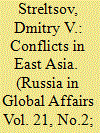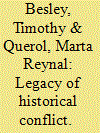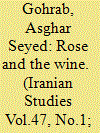| Srl | Item |
| 1 |
ID:
189869


|
|
|
|
|
| Summary/Abstract |
While the threats that turned Europe into the most explosive part of the
world in the last century appear to be quite relevant for Asia, the European-
style security institutions do not seem to work for Asia. The key reasons
are the historically embedded roots of the insecurity, more acute territorial
divisions, specific (non-Western) understanding of security, and ethnically-
driven separatist and irredentist movements. Also, as deglobalization
increases and the international system becomes less and less manageable,
East Asian countries tend to push harder for pursuing an autonomous
security policy.
|
|
|
|
|
|
|
|
|
|
|
|
|
|
|
|
| 2 |
ID:
133023


|
|
|
|
|
| Publication |
2014.
|
| Summary/Abstract |
This article exploits variation between and within countries to examine the legacy of recorded conflicts in Africa in the precolonial period between 1400 and 1700. There are three main findings. First, we show that historical conflict is correlated with a greater prevalence of postcolonial conflict. Second, historical conflict is correlated with lower levels of trust, a stronger sense of ethnic identity, and a weaker sense of national identity across countries. Third, historical conflict is negatively correlated with subsequent patterns of development looking at the pattern across grid cells within countries.
|
|
|
|
|
|
|
|
|
|
|
|
|
|
|
|
| 3 |
ID:
127783


|
|
|
|
|
| Publication |
2014.
|
| Summary/Abstract |
As everyone knows, alcoholic drinks, including wine, are forbidden by Islam. Readers of Persian poetry often wonder how is it possible that Persian wine literature is one of the richest in the world and whether the poets and authors ever address the illicitness of the wine in their works. This article examines how one author, Zang? Bukh?r?, presents a catalogue of positive and negative qualities of wine in his Gul u mul ("The Rose and the Wine"). Through the genre of debate (mun?zara), he shows how a courtly audience may have tried to justify the drinking of wine. The article examines the formal generic characteristics of such debates, showing how the form of the debate is rather appropriate to let forbidden objects or ideas, in this case the wine, speak for themselves thus defending their position in an Islamic society. entertaining in is richness in metaphors and imagery used by the wine and the rose to voice their superiority to each other, but it also addresses a rather controversial topic in an uncontroversial style.
|
|
|
|
|
|
|
|
|
|
|
|
|
|
|
|